Menus
- 3rd evolution for the shock road trail hybrid
- 4 cylinders in line, 1,043 cm3, 120 hp and 102 Nm, KECS electronic suspensions, 257 kg, 16,899 euros
- Discovery
- In the saddle
- In the city
- Motorway and expressways
- Departmental
- Part-cycle
- Braking
- Comfort / Duo
- Consumption
- Conclusion
- Kawasaki Versys 1000 SE video test
3rd evolution for the shock road trail hybrid
4 cylinders in line, 1,043 cm3, 120 hp and 102 Nm, KECS electronic suspensions, 257 kg, 16,899 euros
Unveiled in 2011, the first version of the "Z1000 trail" set new standards in a segment that was already well represented. The first machine of this type with a four-cylinder, the Kawasaki Versys 1000 offered a mix of dynamism and comfort in a typical plastic… household appliances with a nickname of "fridge". Plus GT in 2015, the Versys 1000 is still evolving in 2019 towards road trailering and above all is available in an SE version, more richly equipped, especially in electronics. It is this third version that we are trying on the islands of Lanzarote and Fuerte Ventura (Spain) with contrasting reliefs.
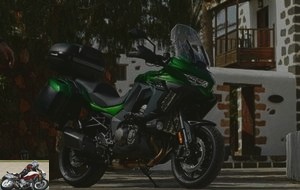
Discovery
The Z family has never been in aesthetic discretion and it is not the Versys version that changes the principle for its 2019 vintage. And like the Z1000SX, it draws on the Ninja sporting heritage with a front end with new tapered lights, encrusted in the return of the fork crown. Entirely led, the lighting has an original light signature, front and rear. Two streamlined slats underline these headlights, directing airflow to the more complexly surfaced shoulders of the fairing. Aerodynamic work makes the volumes more fluid by drawing juxtaposed planes. Above, a new screen slides over 40 mm via two knobs, to be modified when stationary only. The sides form large scoops supporting new turn lights with automatic ignition. Depending on the inclination, one, two or three LEDs light up the sides of the road.
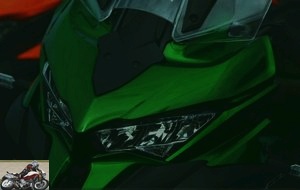
Long-haul road, the Versys still carries a large 21-liter tank. Its large volumes are well integrated and support welcoming seats. In one piece, the saddle offers an imposing passenger space, framed by long grab handles, not to mention a useful luggage rack. The stern ends on a large stylish light. The reinforced rear frame also integrates the suitcase supports. The footrest tubes are welded to the rear trellis, a delicate point in the event of a fall. Composed of a partially sheathed steel tubular assembly, it is bolted to the diamond-type main frame.
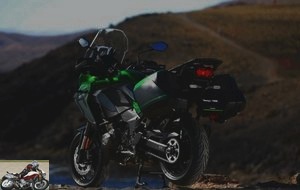
Two aluminum spars pass above the engine carrying function, which makes it possible to narrow the machine and to optimize the rigidity of the chassis. Without major change, the four-cylinder of 1,043 cm3 benefits from silent-blocks on its upper anchor points in order to attenuate its vibrations. Two overhead camshafts control four valves per cylinder. Its 77 x 56 mm super square bore / stroke ratio works well at high speeds to deliver 120 hp at 9,000 rpm. Twin butterfly fuel injection and new Keihin 38mm injectors allow the engine to deliver torque at low and mid-range. The use of these secondary elements controlled by the computer artificially reduces the passage section in order to optimize the filling of the cylinders, whatever the engine speed, for a torque of 102 Nm at 7,500 rpm.
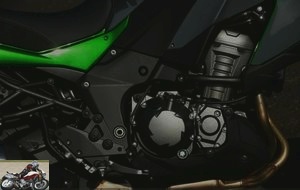
This mechanism is now controlled by a Ride by Wire type throttle, allowing us to choose, on our SE model, three engine maps (Sport, Road, Rain) and even to customize your (Rider). These modes influence the intensity of the traction control and even the setting of the semi-active suspensions. In addition, the personalized mode allows the management of the front and rear damping in compression and rebound according to 10 levels each. !
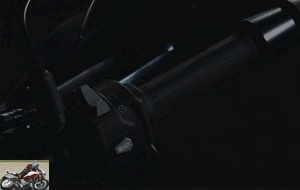
Like the SX, the Versys also adopts a Bosch 6-axis inertial unit (IMU) to optimize the already existing assistance. Longitudinal, transverse and vertical acceleration, roll angular velocity and pitch velocity are controlled. These continuously analyzed data ensure finer management of traction control (KTRC) and ABS (now KIBS), mainly on the angle. This set of functions thus makes up the KCMF, management of cornering. In curves, the IMU will eventually regulate the braking force and the engine power throughout the trajectory, intervening on the brakes and traction control. Through its predictive work, the system no longer waits for slipping or blocking, but can now anticipate problems by knowing the movements of the vehicle …! All he needs is his word.

Another assistance, the "Assist & Slipper" clutch softens the lever and allows gear to be stacked when downshifting. Two types of cams (a lock cam and a slip cam) compress or separate the pressure plates from the clutch housing. In the event of excessive engine braking (downshifting too fast), the sliding cam comes into action. It separates the pressure plates from the clutch housing. This relieves the force exerted on the clutch discs, limiting rebound as well as locking the rear wheel. And the SE also benefits from a quickshifter up and down speed.
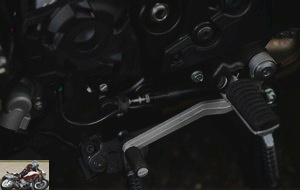
The larger collectors are now connected 1-3 and 2-4. The imposing and heavy catalyst is hidden under the machine, optimizing the weight distribution to end in a short and angular stainless steel silencer with two asymmetric outlets. At its sides, made of a large section of aluminum, the banana-type swingarm easily absorbs the energy of the Kawasaki boiler. The welds of its multiple elements are discreet as are the aesthetics of its matte black finish..
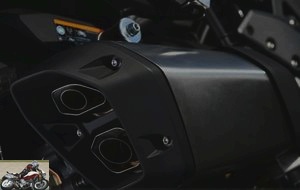
The geometry of the Versys 1000 retains its values: wheelbase of 1,520 mm, caster angle of 27 ° and caster of 106 mm. Values combining stability and dynamism. The SE model features electronically controlled suspensions (KECS). Clearly, the system manages continuously and in less than 10 ms the hydraulic variations to be supplied to the elements. It also adjusts according to the chosen map.
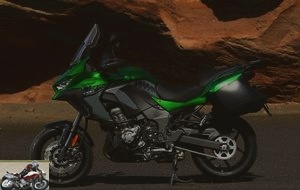
At Showa, we find an inverted fork of 43 mm which debates on 150 mm and a shock absorber of type BFRC Lite, as on the ZX-10R SE, mounted on rod, deflecting on 152 mm. Its construction separates the chamber where the preload force is exerted from those of compression / expansion. On the standard model, the Kayaba 43mm inverted fork is adjustable for compression, rebound and preload; the back-link type mono-shock absorber of the same origin is also adjustable. The hydraulic preload is done via a practical remote control.
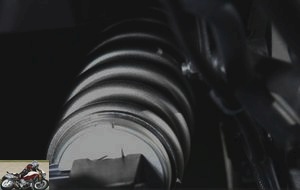
On the braking side, Nissin four-piston radial calipers of different diameters (32 and 30mm) radially mounted drive two 310mm (+10mm) petal discs. A radial master cylinder and the opposing element Tokico single piston clamps a 250mm chainring. The KIBS anti-lock system uses a Bosch 9.1 MP control unit to monitor the wheels, 6-spoke aluminum alloy rims, Bridgestone T31 roadway in 120/70 and 180/55.
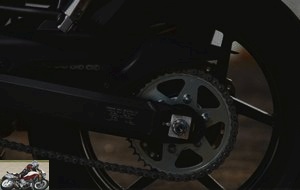
Elegant and racy, the Versys 1000 also takes care of the details. Housings, plates and other metallic elements feature flawless surfaces. Cables and hoses are mostly hidden and two half-shoes protect the lower part of the Japanese block. Well equipped, the Kawasaki offers an accessory socket on the dashboard, cruise control and a center stand. Gracile, the lateral seems to me to have an insufficiently wide support to ensure optimal stability on any surface. Watch out for falls when stopped on unstable or sloping ground.
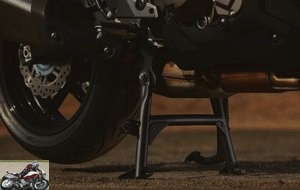
Specificity of the SE model, Kawasaki announces a new durable paint and above all self-repairing! A special layer would allow it, sometimes after a few weeks, to "heal" small scratches. The Bluetooth connection for multimedia allows you to prepare your Versys remotely in terms of suspension, maps, etc..
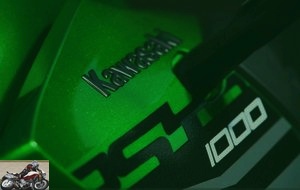
On our SE Grand Tourer model, the 28-liter suitcases each house a full-face helmet, the 47-unit top case accommodates two others and is fitted with a comfortable passenger backrest. Likewise, high hand guards are fitted to the machine as well as additional lights..
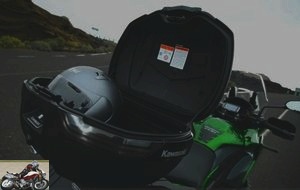
In the saddle
Always as comfortable, among the best on the market, the seats are one of the strengths of the Versys 1000. The rider saddle rises to 840 mm (option 820 mm), not adjustable in height, but the crotch is more narrow. The available recoil is appreciable and the flexion of the legs reduced. The fork shaft lacks elegance, revealing a can of coolant and various wiring.
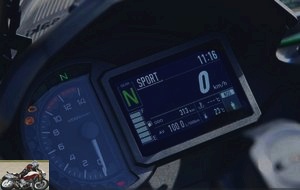
Pleasant, the cockpit accommodates a 12 V socket on the left side and overcomes the counters with a long sun-visor cap. The instrument cluster abandons the reinforced aesthetics of the adventurer type for a more elegant element. It combines, for my greatest pleasure, an analog tachometer with a TFT screen on the SE model (color LCD as standard). Two displays are available (white or black background) and two ergonomics: one of the very refined touring type, the other more graphic or "sport", indicating in bar graph the level of acceleration and braking, the offset of weight during these same phases as well as the angle taken by the machine…
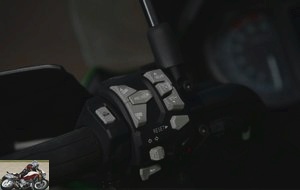
The very well thought out interface is piloted on the two commodos on the handlebars, in particular on the left side. The set makes it possible to easily manage the many functions such as the preloading of the suspensions, to customize the modes and to adjust all the functions. It also provides information on average speed and consumption, journey time, exterior temperature, frost warning lights, engine and fuel temperature gauge, odometer, two partials and clock..
In the city
The big heart of the Versys 1000 SE is discreet when switched on. Its new exhaust and a largely standardized line also modulate its sound imprint. This is not a bad thing for a driver, especially as her voice will wake up more later … And the chanting of Akashi’s four-cylinder recalls all the sportiness of the original Z 1000 block on gas strokes..

It does not take more than 50 meters to perceive the surprising balance of the cycle part. The 257 kilos (253 as standard) vanish as soon as the traveler starts moving. We would direct it with the tips of our gloves. Agile, the Kawa would almost surprise itself with its imposing volumes as its handling is obvious. The high-perched mirrors easily pass over those of the cars and also offer excellent vision. Without the suitcases, the machine is easily placed in traffic.

This ease is accompanied by a general smoothness of operation. The high engine availability makes it possible to operate in built-up areas on the last gear. Without hesitation. Precise, the selection smoothly controls a suitable box. And since the Versys 1000 SE shines very well, it would almost be a city car. But it would be a shame to spoil its potential seduction on the vast horizon.
Motorway and expressways
After 6,000 laps, the Versys 1000 catapults the crew in a powerful roar for a maximum grip of 225 km / h … with all the luggage. We can take more, but more, it was unreasonable given the already well marked movements of the front axle … To not be afraid, we will stay under 160 km / h. Legally, the four-cylinder purrs quietly, at 5,000 rpm on the last rather long report. At this rate, the revivals are however convincing and the road on stilts has something to boost travel. When accelerating, vibrations appear around 6,000 revolutions to disappear 1,000 revolutions higher. In constant mode, nothing to report painful.

Effective, general protection is very convincing. Legs, shoulders, helmet and a good part of the arms are protected from air flow. To see in the rain. For once, we couldn’t test and that’s fine too. Practical, cruise control makes long motorway trips less painful. We would like a more readable gear selection. A fast connecting vessel, the road is also appreciated on less linear routes.

Departmental
The agility of the Kawasaki Versys 1000 SE is even more amazing on the secondary network. Here again, the chassis works wonders and offers great driving pleasure. Skillfully hiding its weight, the GT remarkably limits inertia on angle changes. The lever arm of the large handlebar allows the machine to tilt intuitively. Precise and light, the front axle delivers beautiful neutrality and excellent road feel. Especially on the angle. And from the angle, we take it on our handlebars, up to 49 ° according to the onboard brain. Enough to rub the footrests in each tight curve on the beautiful bitumen of Fuerte Ventura. Placing itself in the eye, the road hybrid fits naturally on its trajectory, effectively modulates the plunge of the steering gear under the bite of the radial calipers and plunges to the rope. We then feel all the electronics working when the rate of passage increases sharply. Fork, brakes and traction control now adjust their assistance to the angle. Amazing and efficient. We feel the fork stiffen then release the hydraulics, the ABS (KIBS) regulates the pressure and gently vibrates the lever … It bumps in there! And it’s effective, especially for peace of mind.
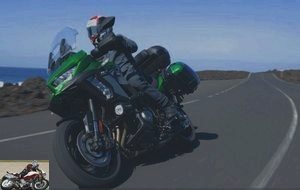
The system adapts the hydraulic pressure of the front calipers and significantly limits the straightening or stiffening of the steering. It also prevents the rear axle from shedding too much, leaving the Versys 1000 perfectly in line even on the strongest decelerations. The modulation of the braking forces also makes this phase more progressive. One-finger operated lever allows control and power of the front grippers.
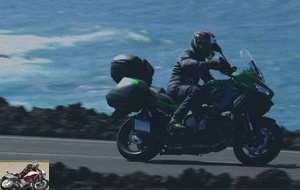
Another good point, the quickshifter is a real pleasure to operate, both on the way up and down. Particularly transparent to downshifting, it provides additional pleasure in the deceleration phase.
No oversteer, the Bridgestone T31 grips the bitumen with tenacity and their carcass allows you to read the road. Their dynamic profile brings a real plus to the handling of the Kawasaki. Ditto when exiting a bend, ensuring excellent traction or in large, fast bends.

Not very demonstrative under 5,000 laps in 6, the big kawa block energizes the Versys with force on the intermediates. Maintained above 6,000 rpm in two or three, it delivers ample raises, easily making the front wheel take off. And its beautiful extension allows to maintain the acceleration for a long time, until the configurable shiflight does not call you to order by getting angry all red. The exhaust then underlines the evolutions of a rather nice hoarse roar. With a more calm look, the Versys 1000 emphasizes its obvious handling and its general smoothness. On a high-performance road, it allows you to drive far and for a long time, without fatigue. On a corrugated iron type road, however, the electronics of the suspensions do not do better than conventional components, sometimes even increasing, it seems to us, the vibratory phenomenon..

Part-cycle
Rigid chassis and dynamic front axle combine with semi-active suspensions to ensure very good comfort, whatever the style of driving and road. Not having been able to compare with the standard suspensions, we still notice the excellence of the damping, on almost any occasion. The relatively large weight benefits from this effective alchemy to be sufficiently forgotten.
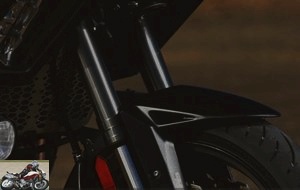
Braking
Efficient, the front calipers deliver power and great modulation to the lever. You can also hold the brakes on the angle for a long time, without parasitic movement. But it slackens all the same on the arsenal in mountain bends. And the weight is there. Two fast-paced emergency braking reassured me that the laws of physics also apply to the Versys 1000.
We will effectively use the rear clamp to seat the road trail on its trajectory. Despite a fairly long stroke, the pedal gives a correct feeling of the retarder.

Comfort / Duo
Soft saddles and quality suspensions always ensure the Versys 1000 a status of wheelchair "club". Pilot and passenger are in the same boat for lounge comfort. The excellent ergonomics of the accompanying handles are also worth noting. Suitcases and top case can accommodate a total of 4 full face helmets. Their simple and efficient operation will optimize trips.
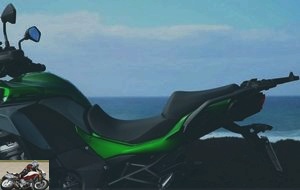
Consumption
In sports driving, our machines show 7 liters consumed per 100 km. A decent average for a powerful machine of nearly 260 kg, taking in addition the luggage. Consumption should be able to drop to 6 liters at a faster pace.
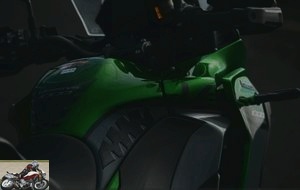
Conclusion
The Akashi company optimizes the pleasure and efficiency of its road hybrid. Raised road, the Versys 1000 SE is more than ever a Kawasaki: atypical, efficient, easy and comfortable. Combining strength and smoothness, the machine is attractive both in the long run and in daily travel. Its new design gives it a strong identity, both sporty and original. Enhancing and plush in its SE version, its appearance also gives it an elegant statutory presence..
Well-equipped, safe and pleasantly finished at all levels, the Versys 1000 SE is priced at 16,899 ¤, the standard version at 13,499 ¤. Not being a proselyte of piloted suspensions and unbridled electronics, a simple equipped version would also be interesting. The Grand Tourer SE pack is а 1,900 ¤
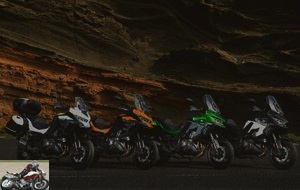
We will oppose him the Honda VFR1200X Crosstourer at 13,999 ¤, 15,899 ¤ with the DCT, which has the advantage of its powerful V4. Comfort is also not to be outdone on board, but its more typical trail style and its high weight are less easy. Between the positioning of a BMW R 1250 GS and R 1250 RT, 17,400 ¤ and 19,500 ¤, the Versys 1000 seems much more affordable. There is also the S1000XR а 17,000 ¤, much more demonstrative in dynamics with its hypersport mechanics.
Well placed in price, the Kawasaki Versys 1000 SE imposes, with this new opus, its style and its road efficiency. To ride fast, different and far, in complete comfort.
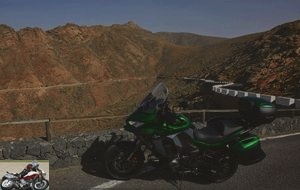
Strong points
- Strong aesthetics
- Engine character and availability
- Agility and efficiency of the chassis
- Unparalleled comfort
- Multiple and convincing electronic assistance
- Quality of suspensions
- Precise selection and efficient quickshifter
- Superb sound
- Quality of finishes
- Overall dynamic efficiency
- Pleasant instrumentation
- Braking
- Aerodynamic protection
Weak points
- Uninviting side stand
- Vibrations during certain driving phases
- Unsheathed fork wells
Kawasaki Versys 1000 SE technical sheet
Test conditions
- Itinerary: winding roads with variable surfacing, dry.
- Weather forecast: sunny, 20 ° C
- Motorcycle km: 220 km
- Problem encountered: ras
Test equipment
- HJC R-Pha 70 Helmet
- Vanucci Tifoso jacket
- Vanucci Speed Profi IV Gloves
- Jean Vanucci Armalith 2.0
Kawasaki Versys 1000 SE video test
Related articles
-
Sport sofa Unveiled in 2011, the first version of the Z1000 trail set new milestones in a segment that was already well represented. The first machine of…
-
Kawasaki Versys 1000 motorcycle test
La Z goes green Eternal absent from the Kawasaki range, apart from the unlikely KLV 1000 (Suzuki V-Str m renamed), the maxi-trail model finally appears…
-
Honda Varadero 1000 XLV motorcycle test
Maxi-Trail with a road vocation The Honda XL 1000 V Varadero, which appeared in 1998, is the heir to the famous Africa Twin … but the manufacturer has…
-
Kawasaki Ninja 1000 SX motorcycle test
Compromise without compromise 4 cylinders of 1,043 cm3, 142 hp and 111 Nm, 235 kg, from 14,349 euros In 2010, Kawasaki presented its first Z1000SX, a…
-
Honda CBR 1000 RR Fireblade motorcycle test
20 years under the sign of total control 1992 saw the appearance of the very first CBR Fireblade, cubing 893 cm3 and has since become a sports icon. At…
-
The way of Reason Teutonne Without going back to the genesis of the 30-year-old RT (Reise-Tourer) lineage, this road model sees its modern lineage dating…
-
Kawasaki Ninja ZX-10R KRT motorcycle test
An integer character 4 cylinders in line, 998 cm3, 203 hp, 114.9 Nm, 206 kg all full facts, 18,099 euros. Nice surprise for me to find the Kawasaki…
-
KTM 790 Adventure and Adventure R motorcycle comparison test
New icon, Easy Adventure 95 hp at 8,000 rpm and 89 Nm at 6,600 rpm KTM, it was the master of the single cylinder, then of the maxi trail but was absent…
-
Honda CBR 1000 RR Fireblade test
The era of e-Total Control A quarter of a century has seen the evolution of one of the most efficient and unique sports cars in the segment: the CBR…
-
Aprilia Tuono V4 1100 Factory motorcycle test
The veloce vita in a bestial roadster, really bestial V4 at 65 ° of 1.077 cm3, 175 hp and 121 Nm, controlled suspensions Ohlins SmartEC 2.0, APRC, 17,999…
More than twenty years after the end of the 850 TRX, here is a device that turns on the light deep in my cortex.
I absolutely have to try this bike.
I imagine a KTM competitor with the 790 for example.
After all, the "small" Italian brands were often right too early, why not?
No sir, there are only two! The TRX and the SS / SSie.
At the limit the VTR F for its "comfort" on the road and the potato of its engine. But she is ugly.
The rest, boaf, the ZX9R is because Kawasaki was too timid to release a 900CBR-like (and it has two cylinders too many), the SV1000 and 650 existed as a roadster so we squirt that out, hop!
Worse, it shouldn’t be too powerful, a road sports car, so the 1000 TLS and TLR, outside too, too many horses.
Same for the Falco, too powerful (and still I like it).
Suddenly, there are not masses left like I said.
Remains the anecdotal MZ1000 (also ugly and existed as a roadster), the Laverda 650/750 (not very pleasant pieces of wood), the Voxan CafeRacer (ok, but it is apart from that it is beautiful), and if we are wide the Triumph Sprint RS 955.
We also forget things like 1000 Thunderace and 600 Thundercat, there are too many cylinders and even notice that for the ZX9R. Not road sportswomen, just timid sportswomen.
No, there are really only of them, pure "road" sports.
One because the Italians know how to make motorcycles, the other because Yamaha had the excellent idea of making it by taking inspiration from the other.
What, what bad faith?
Where? Which?
Well actually since the TRX is a copy of the SSie, there was only one, the Ducati. With the 1000DS, the best engine in the world .
.
More seriously, there is only one thing missing from this Aprilia to bring the genre back to life perfectly: a passenger seat.
The passenger seat replaces the block with fins.
But it’s still a displacer, far from the motorcycles mentioned above.
The RS 660 remains more of a sports bike than a road bike.
The one with the crumbly valve guides…?
Besides, I don’t even see what you’re talking about
Dozens of titles of world champions !! Wow, I’ll have to revise my stats. Surprised …
Surprise: according to my dealer, the passenger seat cowl is optional, and does not even exist in the catalog … although we see it in all the tests!
Anyone have any info on it (veracity, availability, price)?
Answer to myself: info taken from Aprilia: the backsplash is optional, available in May, price not given.
On the new RSV4, it is standard, and already present on motorcycles delivered to dealerships, chui jealous! 🙂
I answer to myself: Aprilia answered me, available in May, price not communicated.
And the motorcycle, during July … like almost all other manufacturers …
Salvation,
That is to say at the intersection of its torque and power curves.
How many times have I read this nonsense ?
For two curves to cross again, they would have to be expressed in the same coordinate system !
With the torque expressed in Newton-meters and the power in horsepower, it’s not won.
Not necessarily :
– there is a common dimension, the x-axis in rpm.
– both curves are usually given in a scale which maximizes visibility, i.e. the maximum of the scale is slightly higher than the maximum torque / power value.
It is therefore logical that the curves intersect regularly in more or less the same way, as long as the coordinate scales respect the above points..
Of course, we should rather speak of the moment when the slopes of the curves diverge, that of torque becoming zero or even negative, and that of power remaining positive..
This is undoubtedly an abuse of language, without a doubt, but not so much nonsense: take a close look at the graphics as they are usually presented, and you will see that most of the time the curves "intersect" at the bottom. moment of change of slope of torque curve.
Well, obviously, you should not have fun changing the ordinate scale (for example by comparing several engines on the same graph) ….
Top toupee! Too bad, sad colors …
Black goes with everything …
Almost all the manufacturers have found more hp, more torque and less consumption with Euro5.
Strongly Euro 10 !!!
we would have to find out how to lose weight it would be much more beneficial than sup ponies
that said, this mob is still so pretty